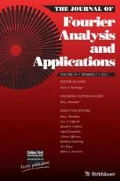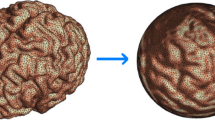Abstract
We investigate the problem of constructing sparse time–frequency representations with flexible frequency resolution, studying the theory of nonstationary Gabor frames (NSGFs) in the framework of decomposition spaces. Given a painless NSGF, we construct a compatible decomposition space and prove that the NSGF forms a Banach frame for the decomposition space. Furthermore, we show that the decomposition space norm can be completely characterized by a sparseness condition on the frame coefficients and we prove an upper bound on the approximation error occurring when thresholding the frame coefficients for signals belonging to the decomposition space.
Similar content being viewed by others
References
Balazs, P., Dörfler, M., Jaillet, F., Holighaus, N., Velasco, G.: Theory, implementation and applications of nonstationary Gabor frames. J. Comput. Appl. Math. 236(6), 1481–1496 (2011)
Borup, L., Nielsen, M.: Banach frames for multivariate \(\alpha \)-modulation spaces. J. Math. Anal. Appl. 321(2), 880–895 (2006)
Borup, L., Nielsen, M.: Frame decomposition of decomposition spaces. J. Fourier Anal. Appl. 13(1), 39–70 (2007)
Borup, L., Nielsen, M.: On anisotropic Triebel–Lizorkin type spaces, with applications to the study of pseudo-differential operators. J. Funct. Spaces Appl. 6(2), 107–154 (2008)
Casazza, P., Han, D., Larson, D.: Frames for Banach spaces. Contemp. Math. 247, 149–182 (1999)
Christensen, O.: An introduction to frames and Riesz bases. In: Applied and Numerical Harmonic Analysis, 2nd edn. Birkhäuser Boston, Inc., Boston (2016)
Daubechies, I., Grossmann, A., Meyer, Y.: Painless nonorthogonal expansions. J. Math. Phys. 27(5), 1271–1283 (1986)
DeVore, R.A., Lorentz, G.G.: Constructive approximation. In: Grundlehren der Mathematischen Wissenschaften (Fundamental Principles of Mathematical Sciences), vol. 303. Springer, Berlin (1993)
Dörfler, M.: Time–frequency analysis for music signals: a mathematical approach. J. N. Music Res. 30(1), 3–12 (2001)
Dörfler, M.: Quilted Gabor frames—a new concept for adaptive time–frequency representation. Adv. Appl. Math. 47(4), 668–687 (2011)
Dörfler, M., Matusiak, E.: Nonstationary Gabor frames—existence and construction. Int. J. Wavelets Multiresolut. Inf. Process. 12(3), 1450032, 18 (2014)
Dörfler, M., Matusiak, E.: Nonstationary Gabor frames—approximately dual frames and reconstruction errors. Adv. Comput. Math. 41(2), 293–316 (2015)
Dörfler, M., Godsill, S., Wolfe, P.: Multi-Gabor dictionaries for audio time–frequency analysis. In: Proceedings of the IEEE Workshop on Applications of Signal Processing to Audio and Acoustics, pp.s 43–46. Mohonk, NY. NuHAG-Coop. (2001)
Dörfler, M., Holighaus, N., Grill, T., Velasco, G.A.: Constructing an invertible constant-Q transform with nonstationary Gabor frames. In: Proceedings of the 14th International Conference on Digital Audio Effects (DAFx 11), Paris, France, 2011
Feichtinger, H.G.: Banach convolution algebras of Wiener type. In: Functions, Series, Operators, Vol. I, II (Budapest, 1980). Colloquium of Mathematical Society of János Bolyai, vol. 35, pp. 509–524. North-Holland, Amsterdam (1983)
Feichtinger, H.G.: Banach spaces of distributions defined by decomposition methods. II. Math. Nachr. 132, 207–237 (1987)
Feichtinger, H.G.: Modulation spaces of locally compact abelian groups. In: Radha, R., Krishna, M., Thangavelu, S. (eds.) Proceedings of International Conference on Wavelets and Applications, pp. 1–56. NuHAG, New Delhi Allied Publishers (2003)
Feichtinger, H.G., Gröbner, P.: Banach spaces of distributions defined by decomposition methods. I. Math. Nachr. 123, 97–120 (1985)
Feichtinger, H.G., Gröchenig, K.H.: Banach spaces related to integrable group representations and their atomic decompositions. I. J. Funct. Anal. 86(2), 307–340 (1989)
Feichtinger, H.G., Gröchenig, K.H.: Banach spaces related to integrable group representations and their atomic decompositions. II. Mon. Math. 108(2–3), 129–148 (1989)
Frazier, M., Jawerth, B.: Decomposition of Besov spaces. Indiana Univ. Math. J. 34(4), 777–799 (1985)
Führ, H., Voigtlaender, F.: Wavelet coorbit spaces viewed as decomposition spaces. J. Funct. Anal. 269(1), 80–154 (2015)
Gribonval, R., Nielsen, M.: Some remarks on non-linear approximation with Schauder bases. East J. Approx. 7(3), 267–285 (2001)
Gribonval, R., Nielsen, M.: Nonlinear approximation with dictionaries. I. Direct estimates. J. Fourier Anal. Appl. 10(1), 51–71 (2004)
Gribonval, R., Nielsen, M.: Nonlinear approximation with dictionaries. II. Inverse estimates. Constr. Approx. 24(2), 157–173 (2006)
Gröbner, P.: Banachräume glatter Funktionen und Zerlegungsmethoden. ProQuest LLC, Ann Arbor, MI, 1992. Thesis (Dr.natw.)-Technische Universität Wien (Austria)
Gröchenig, K.: Describing functions: atomic decompositions versus frames. Mon. Math. 112(1), 1–42 (1991)
Gröchenig, K.: Foundations of time–frequency analysis. In: Applied and Numerical Harmonic Analysis. Birkhäuser Boston, Inc., Boston (2001)
Gröchenig, K., Samarah, S.: Nonlinear approximation with local Fourier bases. Constr. Approx. 16(3), 317–331 (2000)
Heil, C.: An introduction to weighted Wiener amalgams. In: Wavelets and Their Applications (Chennai, January 2002), pp. 183–216. Allied Publishers, New Delhi (2003)
Hernández, E., Labate, D., Weiss, G.: A unified characterization of reproducing systems generated by a finite family. II. J. Geom. Anal. 12(4), 615–662 (2002)
Holighaus, N.: Structure of nonstationary Gabor frames and their dual systems. Appl. Comput. Harmon. Anal. 37(3), 442–463 (2014)
Holighaus, N., Dörfler, M., Velasco, G., Grill, T.: A framework for invertible, real-time constant-Q transforms. IEEE Trans. Audio Speech Lang. Process. 21(4), 775–785 (2013)
Holzapfel, A., Velasco, G.A., Holighaus, N., Dörfler, M., Flexer, A.: Advantages of nonstationary Gabor transforms in beat tracking. In: Proceedings of the 1st International ACM Workshop on Music Information Retrieval with User-Centered and Multimodal Strategies, MIRUM ’11, New York, NY, USA, pp. 45–50. ACM (2011)
Jaillet, F., Torrésani, B.: Time–frequency jigsaw puzzle: adaptive multiwindow and multilayered Gabor expansions. Int. J. Wavelets Multiresolut. Inf. Process. 5(2), 293–315 (2007)
Jakobsen, M.S., Lemvig, J.: Reproducing formulas for generalized translation invariant systems on locally compact abelian groups. Trans. Am. Math. Soc. 368(12), 8447–8480 (2016)
Kutyniok, G., Labate, D.: The theory of reproducing systems on locally compact abelian groups. Colloq. Math. 106(2), 197–220 (2006)
Nielsen, M., Rasmussen, K.N.: Compactly supported frames for decomposition spaces. J. Fourier Anal. Appl. 18(1), 87–117 (2012)
Pielemeier, W., Wakefield, G., Simoni, M.: Time–frequency analysis of musical signals. Proc. IEEE 84(9), 1216–1230 (1996)
Rauhut, H.: Wiener amalgam spaces with respect to quasi-Banach spaces. Colloq. Math. 109(2), 345–362 (2007)
Ron, A., Shen, Z.: Generalized shift-invariant systems. Constr. Approx. 22(1), 1–45 (2005)
Triebel, H.: Theory of function spaces. In: Mathematik und ihre Anwendungen in Physik und Technik (Mathematics and Its Applications in Physics and Technology), vol. 38. Akademische Verlagsgesellschaft Geest and Portig K.-G., Leipzig (1983)
Zibulski, M., Zeevi, Y.Y.: Analysis of multiwindow Gabor-type schemes by frame methods. Appl. Comput. Harmon. Anal. 4(2), 188–221 (1997)
Acknowledgements
We thank the two anonymous reviewers for their constructive comments on the original manuscript. Their valuable suggestions have helped improve the manuscript considerably. Supported by the Danish Council for Independent Research | Natural Sciences, Grant 12-124675, “Mathematical and Statistical Analysis of Spatial Data”.
Author information
Authors and Affiliations
Corresponding author
Additional information
Communicated by Thomas Strohmer.
Appendix: Proof of Theorem 2.1
Appendix: Proof of Theorem 2.1
Proof
To simplify notation we let \(D^s_{p,q}:=D(\mathcal {Q},\,L^p,\,\ell ^q_{\omega ^s}).\) Let us first prove Theorem 2.1(1). Allowing the extension \(q=\infty ,\) and repeating the arguments from the proof of [4, Proposition 5.7], we can show that
for any \(s\in \mathbb {R}\) and \(0<p<\infty \) using Definition 2.2(4). It therefore suffice to show that \(\mathcal {S}(\mathbb {R}^d)\hookrightarrow D^s_{p,\infty } \hookrightarrow \mathcal {S}^{\prime }(\mathbb {R}^d)\) for any \(s\in \mathbb {R}\) and \(0<p<\infty .\) For \(N\in \mathbb {N},\) we define semi-norms on \(\mathcal {S}(\mathbb {R}^d)\) by
with \(u(\xi )=1+\Vert \xi \Vert _2\) as usual. Following the approach in [4, p. 149], and applying Proposition 2.1(4), we get
for sufficiently large N and \(N^{\prime }.\) This proves that \(\mathcal {S}(\mathbb {R}^d)\hookrightarrow D^s_{p,\infty }\) and \(\mathcal {S}(\mathbb {R}^d)\hookrightarrow D^s_{1,1}.\) To show that \(D^s_{p,\infty } \hookrightarrow \mathcal {S}^{\prime }(\mathbb {R}^d)\) we need to take a different approach than in [4]. Setting \(\widetilde{\psi }_T:=\sum _{T^{\prime }\in \widetilde{T}}\psi _{T^{\prime }},\) we first note that for \(f\in D^s_{p,\infty }\) and \(\varphi \in \mathcal {S}(\mathbb {R}^d),\)
Using Lemma 8.1 below (with \(g=\mathcal {F}^{-1}\{\psi _T\hat{f}(T\xi )\}\)) we thus get
since \(|T|=|Q|^{-1}|Q_T|\le |Q|^{-1}\omega _T^\gamma \) according to Definition 2.2(5). Applying (2.2) we may continue on (7.3) and write
for sufficiently large N since \(\mathcal {S}(\mathbb {R}^d)\hookrightarrow D^s_{1,1}.\) We conclude that \(D^s_{p,\infty }\hookrightarrow \mathcal {S}^{\prime }(\mathbb {R}^d)\) which proves Theorem 2.1(1).
The proof of Theorem 2.1(2) follows directly from Theorem 2.1(1) and the arguments in [4, p. 150].
To prove Theorem 2.1(3) we let \(f\in D^s_{p,q}\) and choose \(I\in C^\infty _c(\mathbb {R}^d)\) with \(0\le I(\xi )\le 1\) and \(I(\xi )\equiv 1\) in a neighbourhood of \(\xi =0.\) Also, we define \((\widetilde{f})^{\widehat{}}:=I\hat{f}\) and
with \(\varphi _\varepsilon (\xi ):=\varepsilon ^{-d}\varphi (\xi /\varepsilon )\) and \(\varphi \) being a compactly supported mollifier. Since \({{\mathrm{supp}}}(I)\) is compact, we may choose a finite subset \(T^*\subset \mathcal {T},\) such that \({{\mathrm{supp}}}(I)\subset \cup _{T\in T^*}Q_T\) and \(\sum _{T\in T^*}\psi _T(\xi )\equiv 1\) on \({{\mathrm{supp}}}(I).\) Using Lemma 8.2 below we obtain
with \(\tilde{p}=\min \{1,\,p\}.\) The dominated convergence theorem thus yields
so the proof is done if we can show that \(\Vert f-\widetilde{f}\Vert _{D^s_{p,q}}\) can be made arbitrary small by choosing \(\widetilde{f}\) appropriately. To show this, we define the set \(T_{\circ }:=\{T\in \mathcal {T}~|~I(\xi )\equiv 1 \text { on}\,{{\mathrm{supp}}}(\psi _T)\}.\) Denoting the complement \(T_{\circ }^c,\) Lemma 8.2 below yields
Finally, since \(f\in D^s_{p,q}\) we can choose \({{\mathrm{supp}}}(I)\) large enough, such that \(\Vert f-\widetilde{f}\Vert _{D^s_{p,q}}<\varepsilon ,\) for any given \(\varepsilon >0.\) This proves Theorem 2.1(3). \(\square \)
In the proof of Theorem 2.1 we used the following two lemmas. A proof of Lemma 8.1 can be found in [3, Lemma 3] and a proof of Lemma 8.2 can be found in [42, Proposition 1.5.1].
Lemma 8.1
Let \(g\in L^p(\mathbb {R}^d)\) and \({{\mathrm{supp}}}(\hat{g})\subset \Gamma ,\) with \(\Gamma \subset \mathbb {R}^d\) compact. Given an invertible affine transformation T, let \(\hat{g}_T(\xi ):=\hat{g}(T^{-1}\xi ).\) Then for \(0<p\le q\le \infty ,\)
for a constant C independent of T.
Lemma 8.2
Let \(\Omega \) and \(\Gamma \) be compact subsets of \(\mathbb {R}^d.\) Let \(0<p\le \infty \) and \(\tilde{p}=\min \{1,\,p\}.\) Then there exists a constant C such that
for all \(f\in L^p(\mathbb {R}^d)\) with \({{\mathrm{supp}}}(\hat{f})\subset \Omega \) and all \(\mathcal {F}^{-1}M\in L^{\tilde{p}}(\mathbb {R}^d)\) with \({{\mathrm{supp}}}(M)\subset \Gamma .\)
Rights and permissions
About this article
Cite this article
Ottosen, E.S., Nielsen, M. A Characterization of Sparse Nonstationary Gabor Expansions. J Fourier Anal Appl 24, 1048–1071 (2018). https://doi.org/10.1007/s00041-017-9546-6
Received:
Revised:
Published:
Issue Date:
DOI: https://doi.org/10.1007/s00041-017-9546-6
Keywords
- Time–frequency analysis
- Nonstationary Gabor frames
- Decomposition spaces
- Banach frames
- Nonlinear approximation




